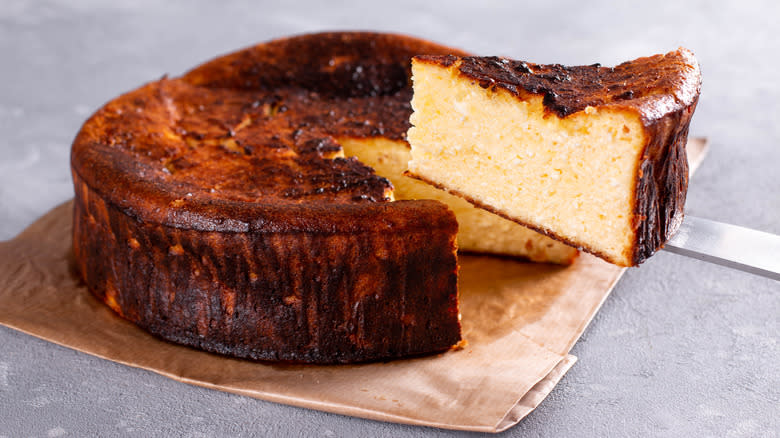The Ancient Greek Origins Of The Classic Cheesecake

Ancient Greece is credited as the birthplace of an astounding number of innovations, from democracy, philosophy, and logic to alarm clocks, theater, and central heating. Among those works of genius on the list, we'd be remiss to leave out one important entry: cheesecake, the eternally beloved dessert whose earliest form can be traced back millennia.
In his 230 A.D. work "The Deipnosophists," a translation of which is provided by Tufts University's Perseus Digital Library Project, the Greek rhetorician Athenaeus instructed home cooks (by way of referencing an earlier cooking-related text) to "take some cheese and pound it" before adding honey and spring wheat flour and forming it "into one mass." Athnenaeus' account alone proves that cheesecake in some form existed nearly two thousand years ago; however, the dessert may have existed even long before that.
Some historians believe a version of cheesecake was served as far back as 776 B.C., when the inaugural Olympic Games took place, though anthropologists have found cheese molds on the Eastern Aegean island of Samos that are even older, dating back to 2,000 B.C. Indeed, Athenaeus credited his recipe in part to the third century B.C. Greek poet Callimachus. So between then and now, how did it evolve into the dessert we know and love?
Read more: 8 Chocolate Bars That Are Totally Different Outside The US
Cheesecake, The Food Of The Gods?

As Rome completed its conquest of Greece in 27 B.C., cheesecake went through some changes of its own. Namely, in addition to crushing the cheese, Romans added eggs and served it warm instead of cold. A recipe for this version, called libum, appears in Marcus Porcio Cato's treatise on agriculture, titled "De Agri Cultura."
Similarly to Athenaeus' instruction, Cato's version says to break up two pounds of cheese in a mortar, add one pound of wheat flour (or a half pound of fine flour for a "dainty" cake), and mix thoroughly before adding an egg. "Pat out a loaf, place on leaves, and bake slowly on a warm hearth under a crock," reads one translation.
Not only was libum served for special occasions, but it was lauded as a food of the gods by the likes of Ovid, Horace, and Virgil. According to Historical Italian Cooking, the latter poet wrote that Priapus, a minor fertility god, preferred his with milk, while Ovid declared that libum must be prepared by an old woman to be considered a worthy offering to Vesta and Liber.
Cheesecake, Then And Now

The spread of the Roman Empire throughout Europe and Scandinavia put libum through a round of culinary telephone. For instance, King Richard II's master cooks, who collaborated on the 14th century English cookbook "Forme of Cury," may have used libum as inspiration for sambocade, their own version of cheesecake made from cheese, egg yolks, saffron, ginger, and salt, baked into a pastry shell. (For all you Old English scholars out there, the original recipe began as follows, courtesy of Oxford University Press by way of A Boke of Good Cookery: "Take and make a crust in a trap & take cruddes and wryng out þe wheyze and drawe hem þurgh a straynour and put hit in þe crust." Huzzah!)
The first record of Sweden's version of cheesecake, ostkaka, came two centuries later, favoring cottage cheese and a dollop of jam on top. German Käsekuchen, made with fresh, unripened cheese, came right on its tail around the 17th century.
As for the New York-style cheesecake you're probably most familiar with, starring a sweet cream cheese filling and graham-cracker crust? Barely preceding the unexpectedly recent origins of pillowy and crust-free Basque cheesecake, the Cheesecake Factory-esque version came into the picture around the 1920s.
Read the original article on Daily Meal.


